Answered step by step
Verified Expert Solution
Question
1 Approved Answer
Calculate the theoretical acceleration when the mass is constant, and the net force is changed. Record the calculations in the data table on the
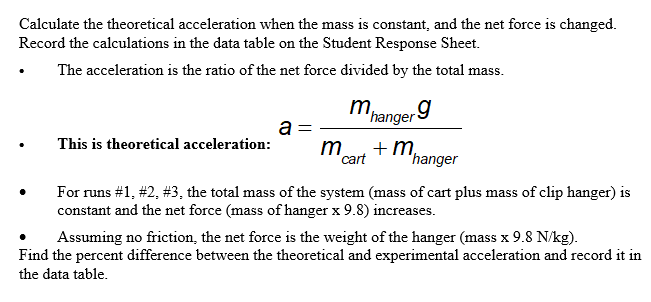
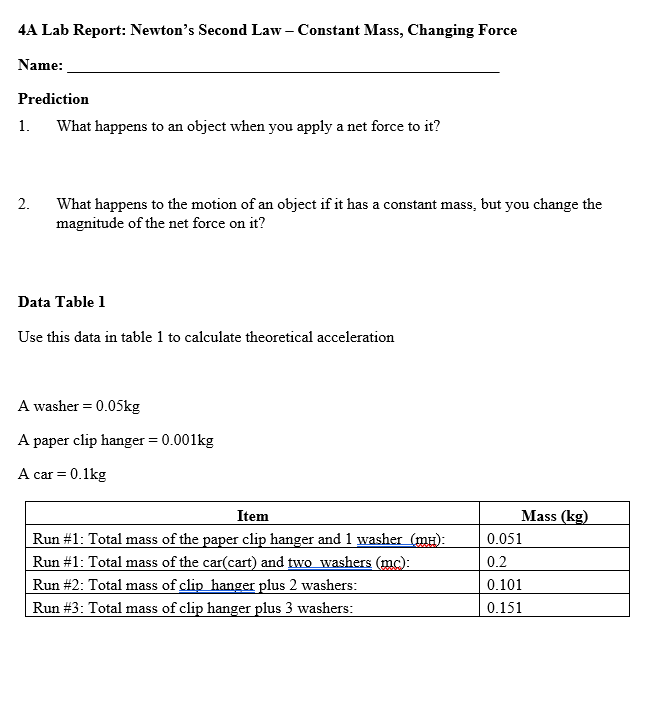
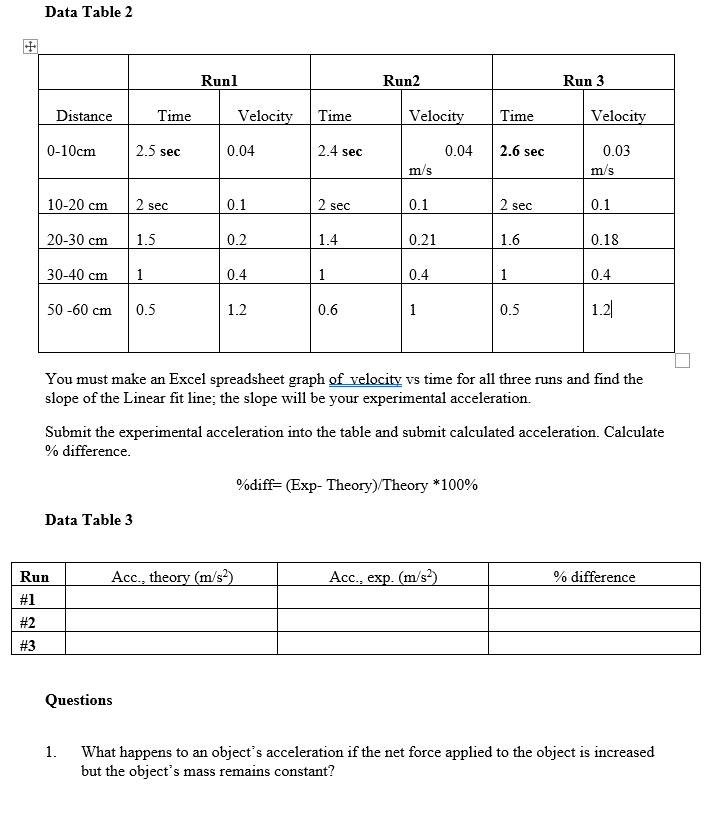
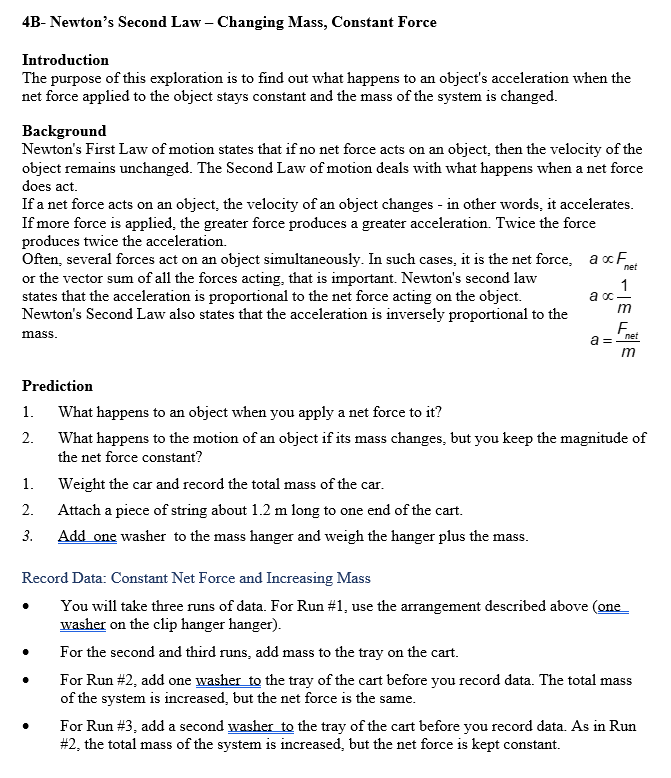

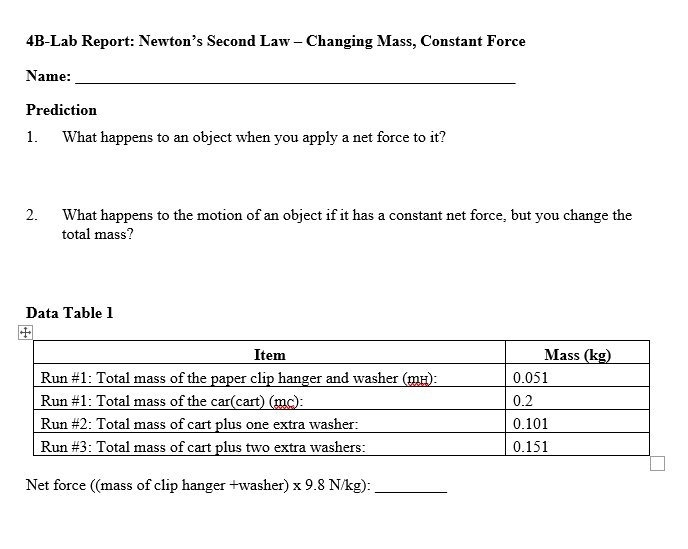
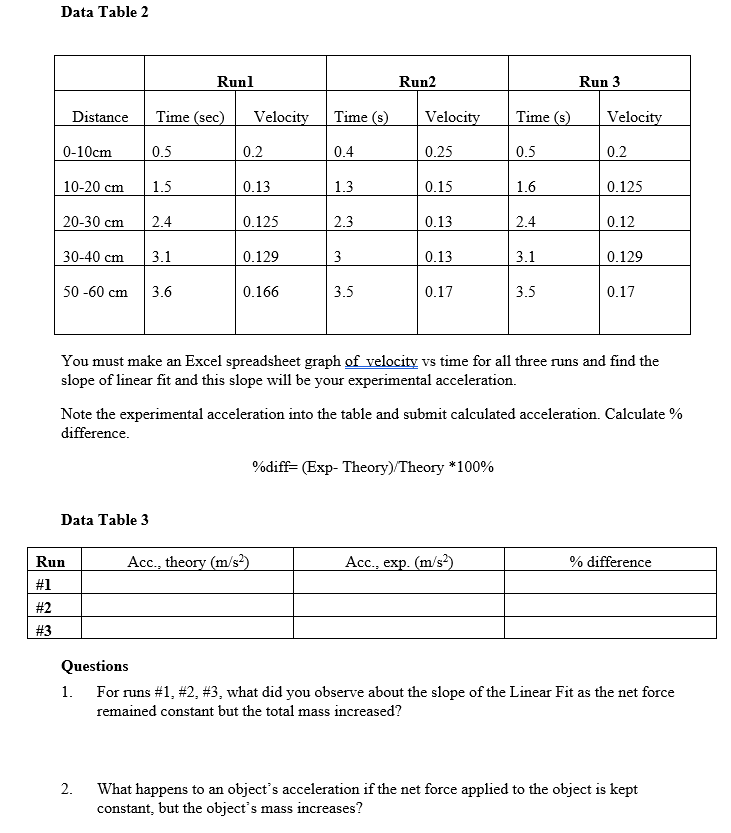
Calculate the theoretical acceleration when the mass is constant, and the net force is changed. Record the calculations in the data table on the Student Response Sheet. The acceleration is the ratio of the net force divided by the total mass. m hanger g This is theoretical acceleration: a m + m cart hanger For runs #1, #2, #3, the total mass of the system (mass of cart plus mass of clip hanger) is constant and the net force (mass of hanger x 9.8) increases. Assuming no friction, the net force is the weight of the hanger (mass x 9.8 N/kg). Find the percent difference between the theoretical and experimental acceleration and record it in the data table. 4A Lab Report: Newton's Second Law - Constant Mass, Changing Force Name: Prediction 1. 2. What happens to an object when you apply a net force to it? What happens to the motion of an object if it has a constant mass, but you change the magnitude of the net force on it? Data Table 1 Use this data in table 1 to calculate theoretical acceleration A washer = 0.05kg A paper clip hanger = 0.001kg A car = 0.1kg Item Run #1: Total mass of the paper clip hanger and 1 washer_(mH): Run #1: Total mass of the car(cart) and two washers (mc): Run #2: Total mass of clip hanger plus 2 washers: Run #3: Total mass of clip hanger plus 3 washers: Mass (kg) 0.051 0.2 0.101 0.151 + Data Table 2 Distance 0-10cm 10-20 cm 20-30 cm 1.5 30-40 cm 1 50-60 cm 0.5 Data Table 3 Run #1 #2 #3 Time 2.5 sec 2 sec Questions 1. Runl Velocity Time 0.04 0.1 0.2 0.4 1.2 Acc., theory (m/s2) 2.4 sec 2 sec 1.4 1 0.6 Run2 Velocity Time 2.6 sec m/s 0.1 0.21 0.4 1 0.04 2 sec 1.6 1 %diff- (Exp- Theory)/Theory *100% Acc., exp. (m/s) 0.5 You must make an Excel spreadsheet graph of velocity vs time for all three runs and find the slope of the Linear fit line; the slope will be your experimental acceleration. Run 3 Submit the experimental acceleration into the table and submit calculated acceleration. Calculate % difference. Velocity 0.03 m/s 0.1 0.18 0.4 1.2 % difference What happens to an object's acceleration if the net force applied to the object is increased but the object's mass remains constant? 4B-Newton's Second Law - Changing Mass, Constant Force Introduction The purpose of this exploration is to find out what happens to an object's acceleration when the net force applied to the object stays constant and the mass of the system is changed. Background Newton's First Law of motion states that if no net force acts on an object, then the velocity of the object remains unchanged. The Second Law of motion deals with what happens when a net force does act. If a net force acts on an object, the velocity of an object changes - in other words, it accelerates. If more force is applied, the greater force produces a greater acceleration. Twice the force produces twice the acceleration. Often, several forces act on an object simultaneously. In such cases, it is the net force, a or the vector sum of all the forces acting, that is important. Newton's second law states that the acceleration is proportional to the net force acting on the object. Newton's Second Law also states that the acceleration is inversely proportional to the mass. 1. 2. 1. 2. 3. Weight the car and record the total mass of the car. Attach a piece of string about 1.2 m long to one end of the cart. Add one washer to the mass hanger and weigh the hanger plus the mass. a= F net 1 m F Prediction What happens to an object when you apply a net force to it? What happens to the motion of an object if its mass changes, but you keep the magnitude of the net force constant? net m Record Data: Constant Net Force and Increasing Mass You will take three runs of data. For Run #1, use the arrangement described above (one washer on the clip hanger hanger). For the second and third runs, add mass to the tray on the cart. For Run #2, add one washer to the tray of the cart before you record data. The total mass of the system is increased, but the net force is the same. For Run #3, add a second washer to the tray of the cart before you record data. As in Run #2, the total mass of the system is increased, but the net force is kept constant. Calculations The acceleration is the ratio of the net force divided by the total mass. mhanger g mart+mhanger a = Find the percent difference between the theoretical and experimental acceleration and record it in the data table. 4B-Lab Report: Newton's Second Law - Changing Mass, Constant Force Name: Prediction What happens to an object when you apply a net force to it? 1. 2. What happens to the motion of an object if it has a constant net force, but you change the total mass? Data Table 1 Item Run #1: Total mass of the paper clip hanger and washer (m): Run #1: Total mass of the car(cart) (mc): Run # 2: Total mass of cart plus one extra washer: Run #3: Total mass of cart plus two extra washers: Net force ((mass of clip hanger +washer) x 9.8 N/kg): Mass (kg) 0.051 0.2 0.101 0.151 Data Table 2 Distance 0-10cm 10-20 cm 20-30 cm 30-40 cm 50-60 cm 3.6 Data Table 3 Run #1 #2 #3 Time (sec) 0.5 1.5 2.4 1. Runl 3.1 2. Velocity 0.2 0.13 0.125 0.129 0.166 Time (s) Acc., theory (m/s) 0.4 1.3 2.3 3 3.5 Run2 Velocity 0.25 0.15 0.13 0.13 0.17 Time (s) %diff- (Exp-Theory)/Theory *100% 0.5 Acc., exp. (m/s) 1.6 2.4 3.1 3.5 You must make an Excel spreadsheet graph of velocity vs time for all three runs and find the slope of linear fit and this slope will be your experimental acceleration. Run 3 Note the experimental acceleration into the table and submit calculated acceleration. Calculate % difference. Velocity 0.2 0.125 0.12 0.129 0.17 Questions For runs #1, #2, #3, what did you observe about the slope of the Linear Fit as the net force remained constant but the total mass increased? % difference What happens to an object's acceleration if the net force applied to the object is kept constant, but the object's mass increases?
Step by Step Solution
★★★★★
3.46 Rating (153 Votes )
There are 3 Steps involved in it
Step: 1
Lets calculate the theoretical acceleration for each run Run 1 Total mass ...
Get Instant Access to Expert-Tailored Solutions
See step-by-step solutions with expert insights and AI powered tools for academic success
Step: 2

Step: 3

Ace Your Homework with AI
Get the answers you need in no time with our AI-driven, step-by-step assistance
Get Started


